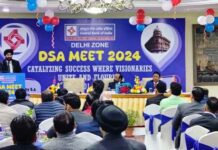Mumbai, Maharashtra, India, Monday, March 04, 2013 — (Business Wire India) — With substantial growth in construction activities and industrial expansion, ensuring energy efficiency and sustainable economic growth is the need of the hour. Comfort cooling and Precision cooling are evolving in commercial segments in India. Keeping this in mind, it is particularly important to analyze the demand for chillers and how this segment is going to unfold in the Indian environment
Among the various types of available air-conditioning products, chillers have proved to be the most effective way of cooling and efficient in saving electric power, compared to other air-conditioning products. Chillers are meant for wider application areas and have larger cooling capacity, typically ranging from 15-1,000 tons of refrigeration (TR). Though they vary in terms of technology, scalability of operation, and energy efficiency, all of them have eco-friendly characteristics.
Apart from traditional functions, chillers have multiple applications, which include process cooling (for industries using absorption technologies), special/critical area cooling (for data centers), marine cooling (for ships and submarines) district cooling, and turbine inlet cooling (especially for gas turbines).
Potential Growth Opportunities
Commercial Sector
A major thrust for the chillers market is expected to come from the commercial sector covering offices, hospitals, hotels, etc. The Indian real estate construction market touched $100 billion in 2010. Going by the growth rate of 10 percent, as was observed during the pre-recession days of 2008, it is likely to touch $265 billion by 2020.
Data Centers
Data centers require massive cooling facilities and this is a major market for the chillers segment. In India, increasing IT business process outsourcing from across the globe has resulted in phenomenal growth of data center facilities. According to Frost & Sullivan, the total third party data center capacity in India was 3.15 million square feet in 2012 and is expected to touch 9.14 million square feet by 2018. Total number of third party data centers in India was estimated to be 98 units in 2012, with majority being located in Mumbai and the National Capital Region (NCR), followed by Chennai and Bangalore.
Turbine Inlet Air Cooling
India is yet to realize the full potential for turbine-inlet cooling in gas-based thermal power plants. Considering the limitations on use of coal for power generation due to its environmental impact, quality, and supply constraints; gas will play an increasingly important role in India’s power sector. Gas-based power generation capacity, along with other renewable sources of energy generation is expected to see more thrust in the 12th Five Year Plan as a part of the low-carbon pathway articulated under the aegis of National Action Plan for Climate Change (NAPCC).
Turbine inlet air cooling (TIAC) is an important element in gas-based power plants. Here, instead of adding more gas-turbine generators, the efficiency or output capacity of existing generators can be enhanced by using chillers. The investment (US$/kilowatt) on chillers for TIAC is much less than the cost of adding additional turbines. Gas-based power plants in the US, Europe, and countries in the GCC are witnessing more and more installations of TIAC using modular chiller plants (MCP) to produce rated or higher-than-rated capacity of power (MW).
Shipbuilding
Shipbuilding is another niche sector where chillers have a potential market in India. A Frost & Sullivan study on the Indian shipbuilding and repair market indicates that the aging fleet of shipping companies in India is a factor that is energizing prospects for the shipbuilding and repair market in the country. The study also suggests that Indian shipbuilders are poised to capture a decent share of global projects, as the order books of Japanese, South Korean, and Chinese shipyards are already full till 2015 with container vessels, super tankers, and Panamax vessels.
Building sustainable cities through eco-efficiency and green planning, district cooling – a concept that is prevalent in the Middle East and other developed nations in Europe – may soon find takers in India as well. One of the seven proposed smart cities to be developed along the 1,500 kilometer-long Delhi-Mumbai Corridor could be a start to test the concept of district cooling. If it succeeds in the Indian context, it can be expanded to include other cities or special investment regions. The chillers market presents lucrative business opportunities and has attracted many international companies to India, which may pose a serious threat to growth of domestic companies. International companies are investing heavily in India to set up manufacturing units or opting for technological alliances with domestic manufacturers to utilize their distribution network.
This Market Insight on the Chillers Market in India is a part of the Building Management Technologies Growth Partnership Service Program. Frost & Sullivan’s related research services include: Select HVAC Products Market in India, Integrated Building Management Systems Market in India, Indian Fire and Safety Products Market and, Indian Facility Management Services (FMS) Market. All research services included in subscriptions provide detailed market opportunities and industry trends evaluated following extensive interviews with market participants.
About Frost & Sullivan
Frost & Sullivan, the Growth Partnership Company, works in collaboration with clients to leverage visionary innovation that addresses the global challenges and related growth opportunities that will make or break today’s market participants.
Our “Growth Partnership” supports clients by addressing these opportunities and incorporating two key elements driving visionary innovation: The Integrated Value Proposition and The Partnership Infrastructure.
- The Integrated Value Proposition provides support to our clients throughout all phases of their journey to visionary innovation including: research, analysis, strategy, vision, innovation and implementation.
- The Partnership Infrastructure is entirely unique as it constructs the foundation upon which visionary innovation becomes possible. This includes our 360 degree research, comprehensive industry coverage, career best practices as well as our global footprint of more than 40 offices.
For more than 50 years, we have been developing growth strategies for the global 1000, emerging businesses, the public sector and the investment community. Is your organization prepared for the next profound wave of industry convergence, disruptive technologies, increasing competitive intensity, Mega Trends, breakthrough best practices, changing customer dynamics and emerging economies?






























